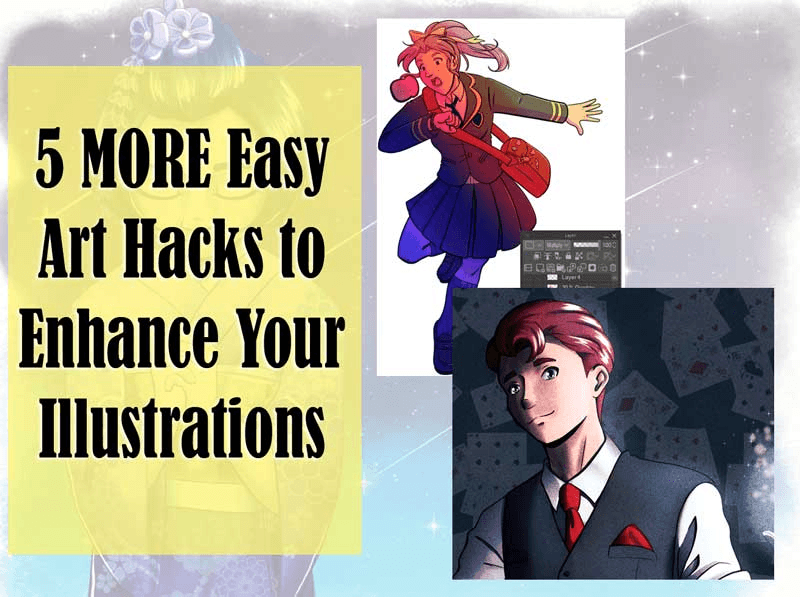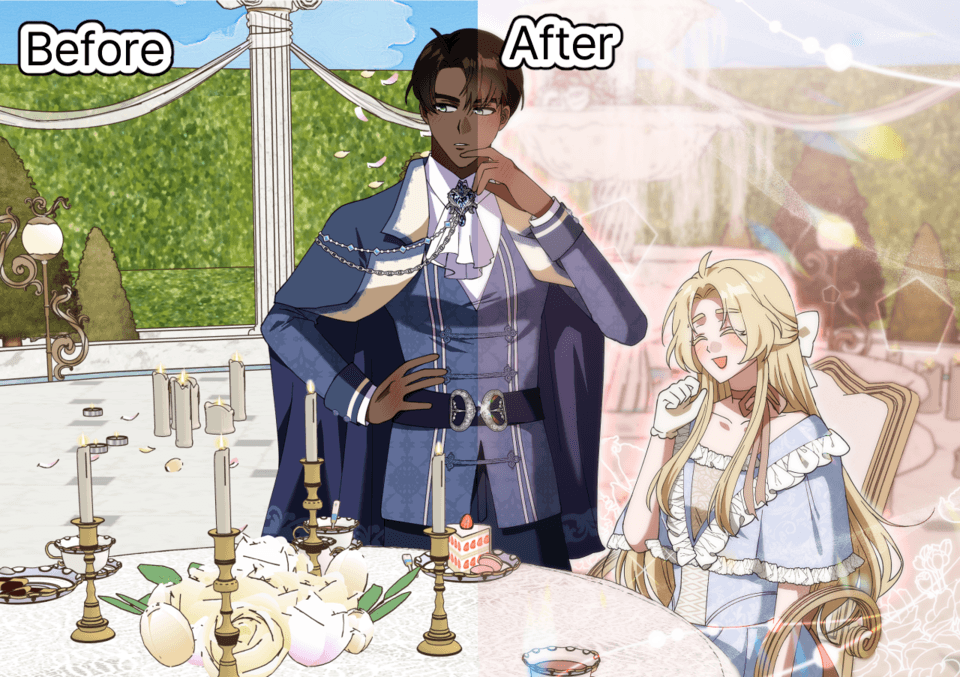The Magic of Blur
Have you ever used the blur effect or filter on your artwork before? If you haven’t, boy-oh-boy let me tell you how life-changing and revolutionary it is! I use blur in almost all of my artworks and thankfully Clip Studio Paint has all the necessary tools for blurring. Blurring helps to add depth, focus, and drama to an artwork.
In this article, I will guide you to learn the blurring techniques and tricks that you can use to enhance your artwork. If you are unfamiliar with the blur filters and tools, I've made a separate article that introduces them which you can check out below.
I’ve done a video guide as well so feel free to watch it!
Blurring Techniques and Tricks
• Blurring the background to focus on the character
If you are making webcomics or simply doing an artwork where you wanted the sole focus be the character, the last thing you’d want is the background art overpowering the character. In order to achieve the background blur effect, you must first make sure the background art is on a separate layer than the character layer.
It CAN be on the same layer however it will be a bit more complicated to blur it out compared to if they were on separate layers.
To blur the background, all you have to do is select the background art layer and then choose the [Gaussian Blur] filter. Set the strength of your blur and voila, you’re done!
As you can see, blurring the background helps to set the focus on your character. Next time you see your artwork being too “messy” because the background mashes together with the character, you can always pull this blur trick!
• Blurring parts of artwork to create drama
When you draw something, partially blurring parts of the artwork would help to add drama to it. Aside from drama, blurring can also help you hide any faults with your drawing.
To do this technique, select the utmost top layer and right click on it to reveal a menu, then click on the [merge visible to new layer] option. This function will merge all the pre-existing layers into a single new layer. This new layer will be your “blur layer” later.
You will now have a new ‘duplicate’ layer. Then, select the [Blur (Strong)] filter to blur the entire new 'duplicate' layer.
Your artwork is now blurred entirely. Now, select the [Eraser] tool and choose [Soft] for the sub tool. Gently erase the parts on the blurred layer that you wish to ‘unblur’.
And you’re done! The artwork is now more dramatic compared to it without the blur. Blurring also helps to cover up “mistakes” in your artwork (for example here you can see that my lineart is slightly messy so the blur helps to cover it up).
The effect is subtle but it definitely helps to add spice to your artwork. For reference, below are some more examples of this trick to create drama.
• Blurring to create depth
Sometimes, you would want to give “depth perception” to parts of your character like the example shown below.
In the example above, you can see the comparison between the character as it is and when the character’s hair at the back is blurred out. It helps to add more depth to the artwork.
To create this effect, merge all of your visible layers into a new layer. The reason we do this is so that we would not mess with the pre-existing artwork.
On the newly duplicated layer, choose the [Selection Area] > [Selection Pen] tool. Make sure to set the selection mode to [Add to selection] so that you can select several separate parts at once.
Then, using the [Selection Pen], carefully select the area that you would like to blur. If your selection went over the desired area, you can just erase the selection using the [Erase selection] tool.
Once you’re happy with your selection, go to [Filter] > [Blur] > [Gaussian Blur] and determine the strength of your blur.
Afterwards, we will edit the color and make it lighter so that we can add the "depth perception vibe” to it.
Go to [Edit] > [Tonal Correction] > [Hue/ Saturation/Luminosity] or you can just press [Ctrl + U] on your keyboard and alter the color slider to your liking.
In case the blurred area looks messy or slightly went over your lineart, don’t worry! Just use the [Eraser] tool or the [Blend] tool to clean up the edges and you’re good to go.
• Creating blurry “movement” effect
This effect is suitable if you’re drawing dynamic poses or have moving objects in your background or foreground. Here are some examples.
A. Dynamic Pose
For dynamic pose, merge all the visible layers into new layer. You will now have a ‘duplicate’ layer.
Select the [Motion Blur] filter from the [Filter] > [Blur] menu. A menu will pop out and you will be able to control the strength and angle (direction) of the blur.
Then, select the [Eraser] tool and choose [Soft] for the sub tool. Erase any parts you think would not be affected by the motion blur, and you’re done!
B. Moving Objects in Foreground/ Background
Meanwhile, if you wanted to apply this filter to moving objects in the background or foreground, first thing first make sure your background art is on a separate layer.
Then, apply the [Motion Blur] filter to the background layer, set the strength and motion, and you’re done!
• Forming echo effect
The echo effect is suitable for creating sense of urgency, echo or even comedy. This effect will create a central focus and blur out everything else around it.
Before you begin, like usual, make sure that you merge all of your visible layers into a new single layer or else the blur filter would only detect the pixels in the current selected layer (unless you are working on a single layer or jpeg/ png file).
Once you’ve merged all the layers, to create the echo effect, simply use the [Radial Blur] filter from the [Filter] > [Blur] menu.
Once you have selected the filter, you are free to control the center of radial by using the “X” marker on the canvas and the strength of the blur using the pop-up slider.
Voila, you now get that "echo" effect on your artwork.
• Creating "glassy" lineart
This is a cool blur trick in case you would like to have glassy lineart where the lineart would appear soft and glowy.
First, have your lineart prepared and then duplicate the layer.
Toggle off the top lineart and we will focus on the bottom lineart layer. Apply [Gaussian Blur] on the bottom lineart and it should turn out like this.
Then, lock your lineart using the [Lock transparent pixels] button. Use the [Fill] tool and recolor the lineart to any color of your choosing.
Afterwards, toggle on the top layer, adjust the blurred lineart’s opacity if necessary, and you’re done! Your lineart should now look soft and glowy!
• Creating smudges
We have been using the blur filter so far, so now let’s do an easy blur trick manually with the blend or brush tool. This time, the blur trick that we will be doing is the smudge effect. Sometimes, your artwork will feature stains or smudges and this is where the blend and brush tool come in handy.
For example, in this drawing here, I wanted to add blood streaks on his face. Create a new layer and use normal pen to draw straight streaks of red.
Then, select the [Blend] > [Finger Tip] tool and lightly dab on the edge of the streaks you’ve made. Now you have smudged blood streaks!
And you’re done! It’s that easy.
In case the outcome doesn’t feel right to you, keep on experimenting with the blend tools. You can also use any brush tool to perform this effect. You can apply this method to everything else similar aside from smudge too such as shading or creating patterns and effects.
• Creating effect to text and dialogues
Lastly, the blur effect is not only applicable to drawings but also text as well. However, you will have to transform the text into image first.
Firstly, type your text using the text tool on your canvas.
Once you’re satisfied with the text, [right click] on the text layer and select [Rasterize] to change the text layer into normal image layer. Once you have rasterized the layer, you will not be able to edit the text again.
Then, feel free to experiment with the blur filter of your liking from the [Filter] > [Blur] menu.
Applying blur effect to your text is extremely useful if you wanted to convey certain moods using the text.
For example, in webcomic, making the dialogues blurry using the [Gaussian Blur] filter can convey as if the dialogues could not be heard clearly whether by the characters or for the readers.
If you apply the [Motion Blur] filter, it can be used to show the dialogues being spoken or heard in a sense of urgency. This filter is also used to show motion with sound effects (sfx).
Conclusion
From the lengthy examples above, I hope you can now see why I love using blur for my artworks. It’s just such a magical tool that adds the extra spice to our artwork. Not just for artworks, I even used blur through the entirety of making this tutorial! Can you spot the blur?
By the way, these are just the basic tips and tricks of the blur effects that you can do in Clip Studio Paint. Try experimenting more by combining various different filters or play around with the brush and blur tools, that way you’ll be able to see more magic in your artwork!
























Comment